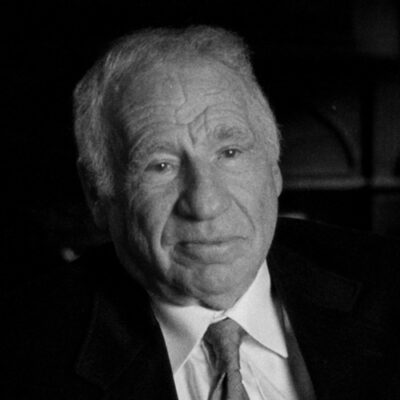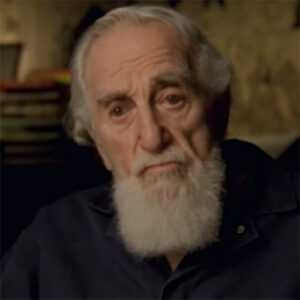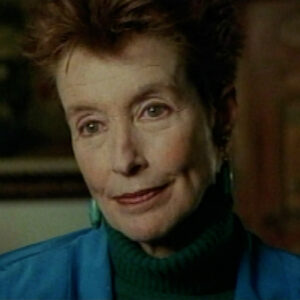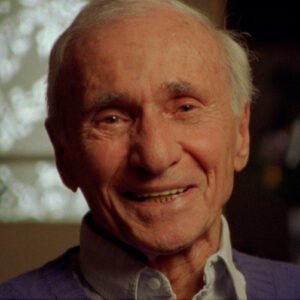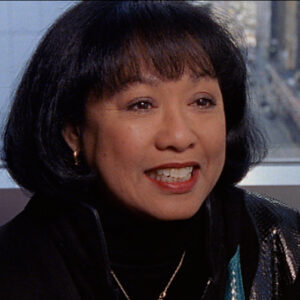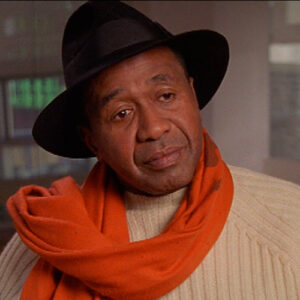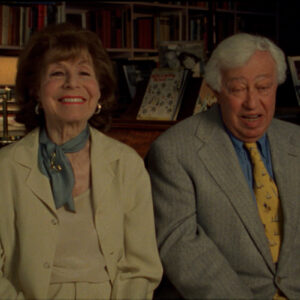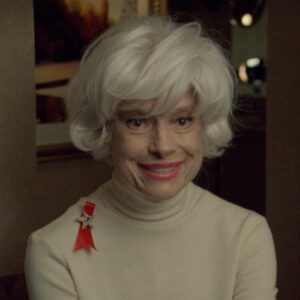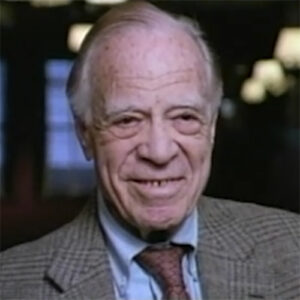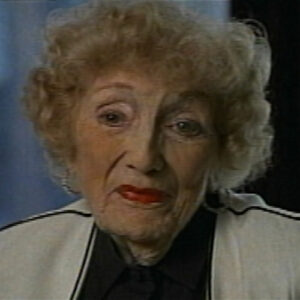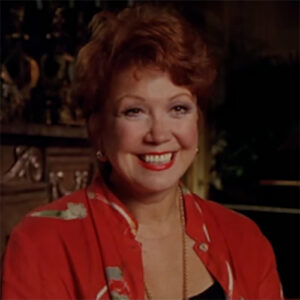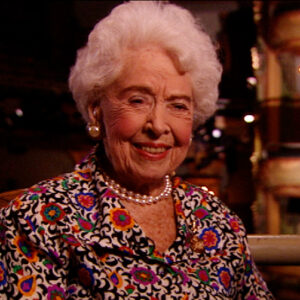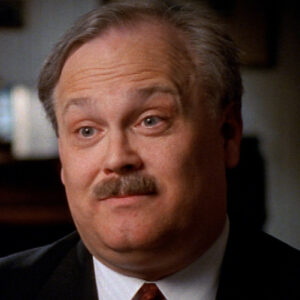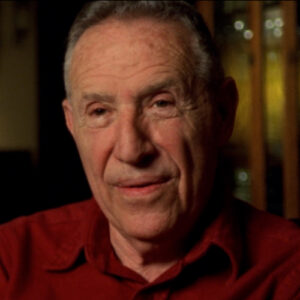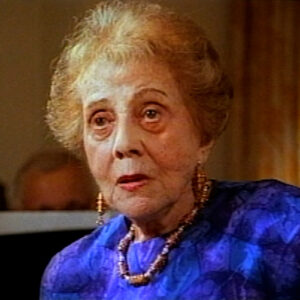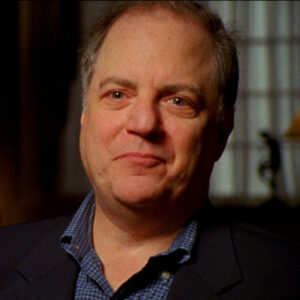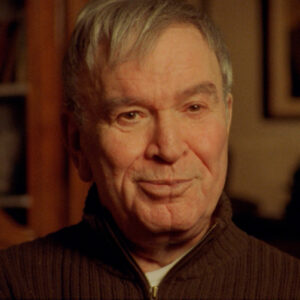Interviewer: So, Ziegfeld Follies, tell me about what was the show like?
Tommy Tune: The Ziegfeld Follies, well, as I understand it, I never saw a Ziegfel Follie. It was four elements, the grandiose and beautiful production numbers, which were Ziegfield’s favorite part of the show, the novelty acts, the sketches, which involved the star, usually, and the comedian type star, and then the tableau vivant. Which were a little bit racier, and so they weren’t allowed to move. They could just stand in all their beauty, the women. And so those four elements are what made the Zichful Follies. And apparently they were really, really long shows. They went on, they were very, very elaborate, and they moved sort of like a leviathan through the seas, but no one seemed to mind. And then, you know, he’d send out Fanny Bryce or Will Rogers or Eddie Kanner, whoever, to. Get the audience back and then he would go into his big dripping with glamor production numbers. That’s how I understand it. Apparently they were gorgeous. I have spoken to people who’ve seen them and oh my god they sounded great. Of course it was all in memory. You know how memory enhances.
Interviewer: So in the 20s and 30s, the Ziegfeld Follies and the reviews, the dancing, there wasn’t that much of a story and the dancing was just, I heard someone refer to it as a leg show. It was very simple. Thank you very much. Thank you.
Tommy Tune: Yeah, I like leg shows.
Interviewer: How did that come to change? Who was the person who really sort of moved it forward? So dance was part of the story.
Tommy Tune: I don’t know about the 20s and 30s. Mostly, see, I love dance routines. And those shows had dance routines, and the few things that I’ve seen from that period are really very interesting routines. And yes, the lines of girls, but also partner dancing, but there was always a gimmick or a novelty because that was sort of coming through the vaudeville thing. You needed something special that made it. Yours. And so the routines in those shows always had a trick to them. Then, in my, I think it all starts with Agnes DeMille, who made the breakthrough, but I’m sure there were forerunners to her. But when Agnes did Oklahoma, it changed everything, because she really furthered the plot and told you some psychological secrets about the characters that. Hadn’t been revealed in dance before in musicals, as I understand.
Interviewer: Tell me more about that. How did she do that?
Tommy Tune: The dream ballet helped a lot, but some of her dances that weren’t dream ballets were also kind of surreal, like girls dancing around in their bloomers, in their underwear, falling on the floor because of their emotions, the essence of growing up and maturing and coming of age, that kind of thing. And then, of course, the guys in Oklahoma had that sort rough and tumble, Western style. Well, dance is a language because before there was language, there was dance. So we have always been telling a story with our bodies. I came home from the hunt. I saw a big beast. I killed a beast. Without the words, those stories were told around the campfire. So the language of dance was language, was the language, with a few grunts thrown in. So. She just transferred. Transferred it into dance terms in the middle of a play, which is tricky to do. She used the dream to do it. It helps if suddenly, oh, well, they’re dreaming. And then you find out all these deeply psychological things about the characters without them talking. But her stories were very, very clear. Very, very, clear to an audience.
Interviewer: Um, jumping ahead to West Side Story, I know that’s a leap, but how is dance used differently in a show like West Side story than the way she used it?
Tommy Tune: You know, I think it’s basically the same. West Side Story in Oklahoma, it’s the same, the milieu is different, but the use of it is actually quite similar.
Interviewer: What did you think of West Side Story the first time you saw it?
Tommy Tune: Well, it was my first job. So imagine getting to come out, da-da-dum, and having those moves. And here I am from Texas, the wide open spaces, and now I’m dancing the part of an inner-city gang member. And the choreography was so specific, and the positions and the shapes were so right in the rhythms, of course, in the music. That was my script, and I knew who I was. And I knew I was, it was a thrilling thing to learn that choreography and see it transform you as a person into a character.
Interviewer: Back to the issue of ballet, does a Broadway dancer have a certain vocabulary or means of expression that a ballet dancer doesn’t? What’s the difference between ballet dancing and then dancing with a Broadway stage?
Tommy Tune: Well, in the beginning, ballet training is just the best training. I mean, that prepares you for almost anything. It makes it a little hard for ballet, strict ballet dancers to learn to tap because their ankles have been so trained to be up and tap dancing is into the floor and they want to defy the gravity of the floor. So, you get a little, you’re at odds with that. But ballet training is is the basic training for Broadway, I think. Jazz is a tributary off, but it’s ballet first. We still talk in ballet terms. I just came from rehearsal with my tap dancing guys, and I’m still using ballet terms in describing what I want. A chasse here and a pirouette there. Even though we’re tap dancing, ballet is the root. Ballet is the highest form. I think, of dance, and so everything comes off of it. With the advent of dancers having to sing, when I first got to New York, we didn’t have to sing. I always sang, so it was fine, but they hired, like, 16 singers, and then they had hired their 12 or 8, the 8 and 8, 16 dancers, oh, there’d be 10 and 10 for a singing chorus and eight and eight. For a dancing chorus, and they would even tell the dancers not to sing because they wanted those pure trained voices. That’s out the window now. There’s no such thing as being really a singer on Broadway. You are a dancer-singer.
Interviewer: And when did that change?
Tommy Tune: Slowly, it started around West Side Story because it didn’t have really a singing chorus. That’s when I noticed that all of a sudden you went to the audition and you had to sing also. And you just started by singing eight bars and then it became 16 bars and they wanted you to sing a whole song. And so that, the fusion started and of course the economics of it, it… It helped if you didn’t have to have two choruses, but you had a dancing chorus that sang.
Interviewer: It was really Jerome Robbins who sort of demanded that his performance be both.
Tommy Tune: It was West Side Story, and then of course the chorus line was the capper, because everybody, that was almost a sung through piece. And it was all dancers, had to be dancers. It was the dancer’s story, but they sang and spoke.
Interviewer: When you saw Chorus Line, was it telling your story to some degree? Absolutely. You were a chorus boy. Tell me about how that’s sort of part of the myth of Broadway.
Tommy Tune: Well, you have to understand that when a course line came out… Broadway was in a slump. There were empty theaters all over the street. We were just at a bad time. Nothing was happening. It was a very, very bad time, and Michael Bennett brought in a chorus line and energized the whole street. And I don’t think we’ve had that dip since. I think a chorus came at just the time when we needed it so badly. And then the next thing that happened was Bob Fossett came up with Chicago and they were running neck and neck. And then it is, we’ve pretty much gone and then the English invasion also helped us a great deal. And so A Course Line was pivotal, pivotal in the salvation of Broadway at that time.
Interviewer: You were very close to Michael Bannon. You worked with him for years. What was his genius? What was great talent?
Tommy Tune: Well, his talents were so diverse. Michael was a genius, and he hated the word, don’t use the G word, darling, don’t use the g word, but he was. I mean, he simply was. He said, genius, I didn’t even graduate from high school. It has nothing to do with book learning, what Michael knew was innate. Michael always said, go with the talent. When he was, and I said, how can you? Cast me in the chorus of the show. And Bayork Lee, who was on the other end of the line, who was 4’11”, and here I am, six, six and a half. And he says, go with the talent. Go with the talents. I think he had a real eye. And he also loved us so much. And we would do anything for him. There’s something about when we dance for Michael that we would just do anything to make it come true for him, whatever he was imagining. We wanted to do it. And he had that built in. Ability to galvanize you. We would just do things that were impossible. We wanted to do it for him.
Interviewer: Okay, just from the from the Gershwin side, we’re sort of looking at him to the Gurshwin.
Tommy Tune: Well, the thing about Fred Astaire was that he came out of vaudeville with his sister. They were Vaudeville Act. And so then they found, see, he had the ability to sing and dance, and she had this great charm, apparently. I never saw his sister, Adele, but in fact, I got my mother to name my sister Adele because I wanted her to be my dancing partner when she got born. I went, oh yeah, AdeLE, perfect. Um They knew how to entertain, and so it was a natural switch from Vaudeville into the legitimate theater for him. Also, he had this gentlemanly upper-crust style that fits so well with the Gershwin songs, and also then later in the movies with the Berlin songs and the Cole Porter songs because he was in the Gay Divorce. He was a natural. He was a natural for it, and then just slid right in into the movies. So it was an easy transition, because he and Adele were not a novelty act, as I understand it. Already had taken the vaudeville routine and bumped it up a notch into a higher class.
Interviewer: What’s Gershwin and his music dancing to it? What’s so great about it? I mean, you did this one-on-one way. So what sort of revelations did you have about Gerswins and how bright it is to dance to them?
Tommy Tune: It’s hard to say what’s in the Gershwin music that gets you dancing, but when you’re dancing it just pours out, it’s not a struggle. Some composers are wonderful composers and their music doesn’t make you dance, or doesn’t make me dance. Gershun and I just fit, it just feels right. But also Berlin, less with Cole Porter, but also with Cole porter. But they’re just… I don’t know that… The falling nature of the chords, the way they blend in, your body starts to go with them. It’s not, it’s not explaining it. It’s a feel. It’s feel. Of a course line, the first performance. I was with Michael in the alleyway before, and of course he didn’t know, he said his worry was that it was so inside that nobody would get it except dancers. And I said, well, everybody’s going to get it because everybody’s tried, been in the position of trying to get a job. Everybody’s tried to have to get job, compete for a job or be interviewed for a job. And that’s what’s under it. Under it all, that’s universal. And the fact that it’s dancers instead of plumbers, it just makes it more theatrical. My life is a cliche, because I’m this kid from Texas. I came to New York. The first day in New York, I went to an audition. I got the job. And I danced in the course of Broadway shows and worked my way up. And it is a cliché, but in New York City, dreams come true. It’s as simple as that. And I guess that’s another thing that attached everyone too. The stories told in a chorus line because eight of those people got the job and the rest of them were eliminated. So, you know, we were pulling for everyone because we want everyone to get the job. So it was involving. It involved the audience. Strong involvement.
Interviewer: Sort of what the Broadway musical is all about in a way is dreams coming true for some.
Tommy Tune: I reckon. Michael Bennett used to say that all great musicals are about brave women and vamps. Boom, boom, boom. That kind of vamp. He was working on Cocoa at the time, so he was influenced, but I love that quote.
Interviewer: Tell me about Michael Bennett’s death. I mean, I know this is, it’s a difficult subject. I think that a lot of people who are going to be seeing this show don’t realize the impact that AIDS had on Broadway specifically. So if you could just sort of take me back to that time and talk about its terrible impact.
Tommy Tune: AIDS, it cut a devastating swath through the talent pool on Broadway. Michael Bennett and Ron Field comes to mind. So many, so many. I can’t even go back through the list. I don’t take their names out of my Rolodex because I want to remember, but there are so many people that worked on Broadway that are gone because of AIDS and in all fields. But a lot of choreographers, dancers, directors. Designers, actors, it really did a number on what comes out on the street. Like Michael was just really getting started, he was a very young man to have accomplished as much as he accomplished. But what he could have come up with in the rest of his life, I want to think about and I don’t want to thing about because it was a big loss, big loss. But that goes for many, many, MANY people are gone because of that. And people that… Died early that we didn’t know what it was it didn’t have a name it was just suddenly somebody’s not looking good the next thing you know they’re gone and then it had a name it still has a name
Interviewer: Obviously, that was a terrible time for Broadway, but do you remember any other times when you just felt like the musical was finished?
Tommy Tune: Well, every other season, we’ve, you know, it’s wonderful what’s happened this season because the producers and Hairspray have really revitalized the American musical. We had the British Invasion, which was basically Andrew Lloyd Webber, but other people too. And those big sort of sung through, they’re more like operettas. But I think they’ve kind of run their course. And we’re looking for the new form, I think, and it’ll be interesting to see what happens.
Interviewer: But you think it’s definitely going to have a…
Tommy Tune: I think that there’s a feeling that an audience gets from seeing a Broadway musical when all the elements are balanced. See, I think the perfect Broadway show is divided in, you divide the pie into thirds. A third is the book, a third is a song, and a third the dance. There would be directors and writers that disagree with me, but I find that if you balance it with those three things equally. You have a better shot at making a delightful entertainment that fires on all cylinders. Of course, the basic thrill of the Broadway musical is that the leading character comes out on stage and sings, love me, love and if it all works, we do, we love her or we love him. We love him and we want for them what they want. And that’s The Broadway plot has to really, really have muscle. It’s got to hit all the way to the balcony. And movies don’t have to have that. They don’t to have to that muscle. In fact, it’s better if they don’t. It can all happen in the eyes. And it’s that movie actors don’t use this. But the Broadway performer has to come from here and socket all the way out to be successful, I think.
Interviewer: And dancers on Broadway have to have that big gesture. That’s the sort of dance they’re doing. Well.
Tommy Tune: Well, dance is gestural, it’s when you can’t talk anymore or sing anymore, you dance to express it.
Interviewer: What does the Broadway musical say about America?
Tommy Tune: Wow.
Interviewer: I mean, why was it created here? Why wasn’t it, you know?
Tommy Tune: I think there’s a verve and a muscle in an I can do this kind of thing and why not and if I feel like singing right now because I’m happy I’m gonna sing and if I if I’m so happy that I can’t sing anymore I’m going to dance I think that’s basically the American optimism it’s not that way in Britain there’s more of a we’re more contained and well perhaps I’ll dance around a bit But here we, you know, we just go. That’s American energy. I think that’s why the musical came out of this country. It’s like one of our great contributions to world culture. It’s intrinsically American, the energy that it takes to do a musical, to make a Broadway musical is an intrinsically american energy.
Interviewer: And what do people, what are they looking for when they go to a musical audiences?
Tommy Tune: To be taken out of themselves, to forget their sitting in their seats, to forget there day, if nothing else. And hopefully if we do it right, then that’s an evening that we provide for them, that’s live, that can never be duplicated, that goes into their heart and soul and they move the memory of it up into the apartments of their mind and then that resides with them. For the rest of their lives. I have those, those memories of shows that I’ve seen. Will always be with me till I die, I have those memories. And that’s special because you can’t put them on your video machine and play them back. That it doesn’t work that way. It’s more personal because it comes directly from the stage to you. And then it moves into your soul.
Interviewer: So what does a Broadway dancer do on a Broadway stage? He doesn’t do it anywhere else.
Tommy Tune: The Broadway dancer is different than any other kind of dancer in that they have to amalgamate character, vocal prowess, and dance. They have to do it eight times a week. And that’s tough, because like in any sport, you pull a muscle or something, then you sit that game out. That doesn’t work on Broadway. You have to show up. You have show up, it’s a commitment. It’s a life commitment. And it’s something that either you have inside of you and you have to it. Or maybe you should go sell hamburgers instead, because it’s not for sissies, contrary to popular belief. It’s hard, hard work, but you do it because you have to do it, otherwise you’ll implode. That was my energy coming to New York. They said, you are too tall to dance in the chorus of a Broadway show. And I knew I couldn’t start out being a star. You gotta work your way up the ladder. And I couldn’t be bothered that I was too tall. To dance in the course of a Broadway show. I had to do it. I had do it, and I did.
Interviewer: Three adjectives and say, co-porter, and then say, you know. Co-porter. Off the top of your head. Okay.
Tommy Tune: Cole Porter, sophisticated, urbane, dirty.
Interviewer: Bob Fosse, sort of what was his genius, what was so wonderful about him?
Tommy Tune: I just love Bob Fosse’s work. He was a minimalist. If he was an artist, he would be an extreme minimalist. He would build a dance on three things, three steps, if you will, and he wouldn’t throw in anything else because he didn’t need it. He just so refined his three-card money, just would give you three things and that was the number. And it didn’t need to be anything else. And it was. You know, thrilling through the roof. I just adored his work. I just, he was the living end. And he also came, not so much out of Vaudeville, but out of kind of burlesque, cause he started being the dancing guy in burlesques shows. So it always, you know it had a very strong sexual underpinning. It was a lot of pelvis. Beyond the sex of it, it was the control of it. He would, like, if he was an artist, he would paint in black and white and occasionally, occasionally, give you one little thin red line and that was it. And I adore that, because I’m also an artist. I paint and I try to limit my palette when I’m painting. Not successfully all the time, but he had it down. Broadway is blue collar work, from the star down to the least working chorus member, the one that dances in the back, it’s blue collar. We sweat for a living, that’s just the truth of it. We put on our uniforms, we get out on that stage and we work as a team. To win every night. To get the ball in the basket every night. Because it’s no good that we made a hole in one last night. We have to do it tonight. And a lot of sports figures that have come to see my shows come back, and we talk about that. Martina came back and she said, if I were ever to be any kind of a theatrical performer, it would have to be live on a stage because I equate it with the game. It’s the same. You gotta get it. You got to get it back over the net every time. That’s the gig. So we all basically sweat for a living, and our dressing rooms are like locker rooms.
Interviewer: Another sort of arduous aspect of being on Broadway is the tour. Can you just sort of tell us what role that plays?
Tommy Tune: Well, I love touring. I’m nomadic by nature. I’m partially a Shawnee Indian. And that tribe followed the sun. They never built buildings like the Pueblos. One thing that comes to mind is Gene Kelly, when I work for him, he gave me the best direction I’ve ever received. He said, Tommy, dance better. And coming from Gene Kelly, you know what that means. So I’ve used it a lot. Listen, dance better. I think it’s a good thing to say. Carol Channing has always given me great advice. I was getting ready to play Vegas for the first time. And I said, how do I play Vegas? And she said, you start with the finale and go up from there. There are a lot of people who have said great things to me about doing what I do and passing it on. Michael Bennett, still I hear him all the time, but specifically when I’m casting a show, go with the talent. He didn’t care if they were the right types, he didn’t. We were doing a show set in Tennessee, and we had such a mish-mash of… Strange people that would never have found their way to Tennessee at that time in history. He didn’t care. He just said, I’m going with the talent. There we were. Because the whole thing is dance for me. When I see a Broadway show, the whole movement pattern of the whole piece is the choreography. But then I’m different. I look at a herd of birds flying through the air, and that’s choreography to me. I see the I have a weeping willow tree on my terrace and when the wind blows and those leaves go out and are horizontal to the wind, I mean to the floor, that’s one of the great pieces of choreography I’ve ever seen. Quaking leaves on an aspen up on the mountaintop, that is choreography, a swan moving through the water. Those little birds that go down to the ocean and come back, sandpipers, I just love them. They are. And Fossey thought that too. In fact, he says this is the Sandpiper number and the way he moved them. It’s choreography is everywhere. I just love to watch people walk down the street. I think one of the most important things a person can learn when going into the theater is to walk. It’s terribly important and some people don’t have any control of their bodies just to walk on a stage. It takes a lot of nerve and chutzpah in courage and thought. To make an entrance, to walk on a stage, is not to be underestimated. So when I see a show, it’s all choreography, even if it’s a play. It’s choreography. Good element to put in a show though, choreography. Think about it.
Interviewer: Business of show business, the pressure.
Tommy Tune: Yeah, well, it is, it’s show business, and so you have to take into account both of those things. Sometimes, though, the way through is to make a piece artfully. It’s surprising how an audience will respond to art. If it’s just arty without being artful or pretentious without being heartfelt, maybe it doesn’t work. And then some god-awful shows come through that are just tripe, that are absolutely sensational hits. I will not mention any names. That you go, how can this be? Look at these people responding to that junk. And yet, that’s all sort of wonderful, too. It is. You know, as long as people are coming and they’re having a great time, how can we judge? Well, it’s not my cup of tea. Well, It’s not My Cup of Tea, but you can’t knock the fact that it’s a success.
Interviewer: And then 42nd Street, what is your take on the new 42nd?
Tommy Tune: The new 42nd Street looks pretty much like the old except it’s just brighter. It certainly is naughty and gaudy and body and sporty as 42nd street ever was. I remember it when I first got to New York. I’d never seen anything like it and it’s basically the same, just more.
Interviewer: You think it’s sort of making an optimistic statement about the future of the musical, the future show business up there in that neighborhood.
Tommy Tune: Well, I’m taking it to heart because I’m getting ready to open a show on 42nd Street. I’ve never played 42nd street before so that feels like maybe it’s a return to the Ziegfeld days, you know, of elegance, perhaps, because that’s where his theaters were. Broadway is really a magnet from all over the world, but specifically America. People come from allover to make it. Well, the song, if you can make it there, you’ll make it anywhere. It’s kind of like the it place to kick off. Also, it’s a wonderful place for reinvention because, I mean, Fred Astaire was not born into regal life, he just became that. He reinvented himself into that. And I think it’s possible to do that in this city because nobody knows your real story so you can be anything you want to be.
Interviewer: What was your story when you got to New York?
Tommy Tune: Well, I didn’t bring my, I brought my tap shoes, but I hid them in the bottom drawer of my chest of drawers and my friend said, don’t tell anybody you’re a tap dancer in New York, because it was out. It was West Side Story. Don’t tell anyone that you’re tap dancer, they’ll laugh you off. And so you didn’t even audition tapping for Broadway shows at that point. And then little by little, it started coming back. And now it’s sort of a staple. People enjoy it, but it was totally out when I got to New York, so I just played like I didn’t know how to do that. Then it came in handy.

